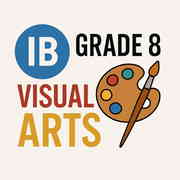Professional Courses
Industry-relevant training in Business, Technology, and Design
Categories
Interactive Games
Fun games to boost memory, math, typing, and English skills
Typing
Memory
Math
English Adventures
Knowledge

IB Grade 8 Visual Arts
This course invites students to explore the diverse world of visual arts as a powerful means of expression, communication, and cultural understanding. Through hands-on creation, critical analysis, and reflective practice, students will develop technical skills, foster creative thinking, and deepen their appreciation for the role of art in shaping individual and collective identities across different times and cultures. "Art as a Lens" encourages students to use visual art to investigate global issues, challenge perceptions, and connect with their own experiences and the wider world. Emphasis will be placed on developing a robust process journal to document inquiry, skill development, creative thinking, and personal reflections throughout the artistic journey.
Course Chapters
Unit 1: Unveiling Identity: Self-Portraiture and Cultural Representation
The chapter emphasizes the intertwining of self-portraiture and cultural representation, illustrating how art can encapsulate personal and collective identities. Through historical and contemporary examples, students explore various techniques and cultural significances associated with self-portraits while developing their artistic skills. The learning objectives guide students towards understanding identity through their art, fostering critical engagement and personal expression.
Unit 2: Art and Environment: Shaping Our Surroundings
This chapter emphasizes the integral role of art in reflecting and shaping our environments, especially concerning sustainability and globalization. It explores various forms of environmental art that engage with ecological issues and community participation. Practical skills in sculpting techniques and digital creation are highlighted, culminating in a studio project that communicates meaningful environmental themes.
Unit 3: Visual Storytelling: Narratives Through Imagery
Visual storytelling serves as a powerful medium for conveying narratives and emotions through images, transcending language and cultural barriers. The chapter explores various forms and techniques of visual art, emphasizing the importance of composition, character design, and creative expression in crafting compelling stories. Additionally, it encourages experimentation with different artistic mediums to enhance narrative depth and engagement.
Unit 4: Art and Technology: Innovating Visual Experiences
Art and technology converge to redefine artistic expression and broaden the concept of visual experiences. The integration of digital tools in art fosters innovation, allowing artists to experiment with new aesthetics and interactive modalities. This exploration includes studying contemporary artists, practical applications of digital mediums, and insights into the implications of technological advancements in art.
Unit 5: Art for Advocacy & Social Change
Art serves as a profound medium for advocating social justice and prompting change, harnessing visual communication to instigate dialogue and reflection on critical issues. Through historical and contemporary examples, the significance of effectively employing artistic techniques and communication strategies becomes evident. By developing a nuanced understanding of these elements, artists can create impactful works that resonate with audiences and inspire action towards social and environmental justice.
Unit 6: The Language of Abstraction: Form, Feeling, and Concept
The unit delves into abstract art, exploring its meanings and expressions beyond realistic representation. Through historical context, artistic techniques, and cultural influences, students engage with abstraction creatively and intuitively. By learning to analyze and create non-representational art, students enhance their understanding of aesthetics and emotional communication.
Unit 7: Functional Art & Craft: Form Meets Purpose
The exploration of functional art and craft highlights the essential interplay between form and function, illustrating how aesthetically pleasing designs can fulfill practical uses while reflecting cultural values. By examining various traditions and engaging in hands-on projects, students will acquire skills in crafting functional art objects, fostering creativity while adopting principles of artistry and utility. Ultimately, the unit emphasizes the importance of innovative design thinking in merging the beautiful with the practical.
